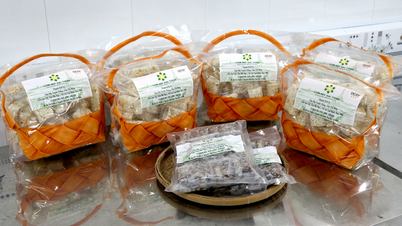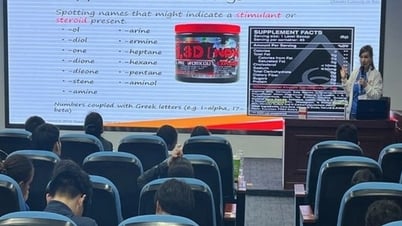Recently, the Department of Tropical Diseases, Phu Tho General Hospital received and treated a patient with meningitis caused by Streptococcus suis.
Patient VHK born in 1966 in Doan Hung, Phu Tho was admitted to the hospital with high fever, headache, nausea and vomiting. The patient had a rash of petechiae under the skin, slow contact, and hearing loss (previously the patient had normal hearing). It is known that about 10 days before the fever, the patient ate pig intestines.
 |
| Illustration |
Seeing that the patient had signs of meningitis, the doctor of the Tropical Diseases Department ordered a lumbar puncture for the patient to do blood and spinal fluid culture tests. The results showed that the patient was positive for streptococcus (Steptococcus Suis); the spinal fluid had 350 cells; Protein 1,017; Glucose 0.97.
The patient was diagnosed with meningitis caused by Streptococcus Suis and was treated according to the antibiotic chart. After 21 days of treatment, the patient recovered, was in stable health and was discharged from the hospital.
In the case of patient K., doctors thought of the situation where the patient ate pork, pork intestines... containing streptococcus bacteria but the preparation did not meet the requirements (not cooked or used the same tools to cut raw and cooked food...).
Therefore, doctors recommend that people should choose fresh, disease-free foods that ensure food hygiene and safety. Do not eat blood pudding or raw or undercooked meat.
When processing, make sure to cook thoroughly, use separate utensils for processing raw and cooked foods such as knives, cutting boards, scissors, bowls, plates, etc. When preserving food, pay attention to keeping raw and cooked foods separate to avoid cross-contamination.
After slaughtering pigs or processing raw pork, wash your hands with antiseptic solution. Avoid contact with sick pigs to avoid health effects.
Also regarding streptococcus, the Intensive Care Unit, Central Hospital for Tropical Diseases received a 57-year-old male patient (in Yen Bai ) transferred from Yen Bai Provincial General Hospital with a diagnosis of septic shock due to streptococcus.
Dr. Pham Van Phuc, Deputy Head of the Intensive Care Unit, said that before being hospitalized, the patient was still performing his daily pig slaughtering work.
But just 3 hours after the pig surgery (around 10am), the patient had a fever, fatigue, followed by abdominal pain and vomiting. The patient was admitted to a medical facility near his home and transferred to Yen Bai General Hospital where he was diagnosed with septic shock and monitored for streptococcus suis.
From 2:00 a.m. on June 17, the patient developed rapidly increasing necrotic hemorrhagic rashes on the skin accompanied by respiratory failure. He was intubated and transferred to the Intensive Care Unit in critical condition.
Upon admission, the patient had generalized edema, multiple hemorrhagic necrosis of the whole body and face, multiple organ failure, liver and kidney damage, blood clotting disorder, etc.
The patient was diagnosed with septic shock suspected to be caused by Streptococcus suis, and was prescribed continuous blood filtration and other procedural interventions.
Doctor Phuc shared that recently, the Central Hospital for Tropical Diseases regularly receives and treats cases of streptococcal disease transferred here.
Many patients were admitted to the hospital in critical condition, with multiple organ failure and severe blood clotting disorders. Some patients were cured but had to have their necrotic fingertips or toes amputated….
Streptococcus suis is caused by the bacterium Streptococcus suis. Infection with Streptococcus suis is rare in humans. However, humans can become infected and develop the disease through contact with sick pigs or products from sick pigs.
Streptococcus suis can be transmitted to humans through contact with sick pigs or pigs carrying the bacteria through small lesions or scratches on the skin of people who slaughter, process or eat pork or undercooked blood pudding from sick pigs or pigs carrying the bacteria.
Streptococcus suis is found in many parts of the world where pigs are raised. The bacteria usually reside in the upper respiratory tract, especially in the nose and throat, in the digestive and genital tracts of pigs.
In humans, the most common manifestation is purulent meningitis (96%) with common symptoms such as fever, headache, vomiting, stiff neck, and impaired perception. 68% of cases of purulent meningitis have symptoms of tinnitus and deafness.
Severe cases can rapidly progress to septic shock syndrome, circulatory collapse, hypotension, severe coagulation disorders, hemorrhagic necrosis, embolism, multiple organ failure... coma and death.
To prevent streptococcus suis, doctors recommend that people cook pork thoroughly. Do not eat dead pigs, do not eat rare dishes, especially pig blood pudding. Use protective equipment (gloves) when slaughtering and processing raw pork.






![[Photo] General Secretary To Lam attends the 80th anniversary of Vietnam's diplomacy](https://vphoto.vietnam.vn/thumb/1200x675/vietnam/resource/IMAGE/2025/8/25/3dc715efdbf74937b6fe8072bac5cb30)





























































































Comment (0)